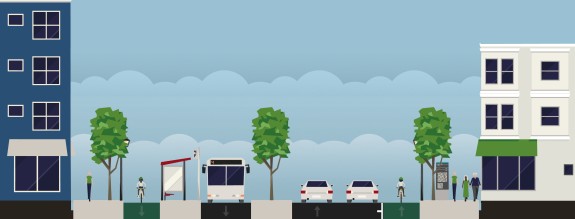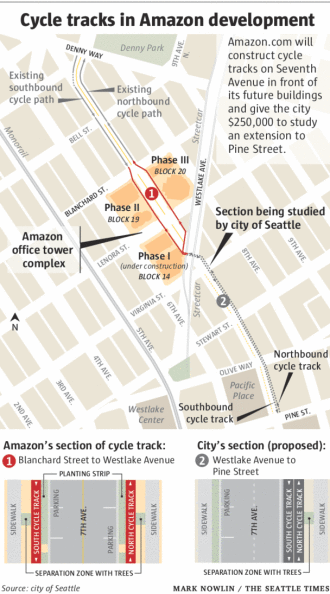
The Seattle Times’ Jonathan Martin said in a column today that the city’s low-budget street safety projects (AKA road diets) have worked really well. He suggests that the city should do more of them, including a project to address serious ongoing safety issues on Dexter Ave between Mercer and Denny.
Martin cites this Seattle Bike Blog post from August in which we suggested some ways the road could be made more safe. Essentially, we argued that Dexter is too wide with too many lanes despite the fact that relatively few people are using it. This “excess capacity” (to use engineering terms) encourages speeding, and the width and number of lanes makes it difficult for people to safely make left turns.
Several serious recent collisions, including the one that killed Mike Wang in 2011, occurred when someone making a hurried left turn struck somebody traveling in the bike lane. With fewer and skinnier travel lanes, better sight lines and a low-stress left turn lane, the road could be made much safer.
Seattle Department of Traffic traffic engineer Dongho Chang agrees that stretch of Dexter is troublesome, and is on the city’s list for study next year. The road has more capacity than it needs (with 13,000 vehicles a day, per a 2011 count), which encourages speeding, Chang said. It’s a good bet, in my opinion, the recommendation will be a road diet — reducing four lanes to three, one lane of traffic each way with a center turn lane.
I’m sure that will prompt outcry about a bogus “war on cars.” So let’s look at the evidence: What has happened with other road diets?
With Stone Way North, dieted in 2008, an SDOT before-and-after study found traffic volumes stayed relatively constant, but collisions and injuries dropped as the rate of speeding fell, and and traffic wasn’t diverted on side streets (one measure of cars dodging a clogged roadway).
Ditto for West Nickerson Street, according to an SDOT report, between the Ballard bridge and Fremont. Fewer speeders and collisions, constant traffic volumes. West Seattle Blog reports about Fauntleroy Way Southwest follow that trend.

And, of course, Dexter will connect to a planned cycle track on 7th Ave (see right), which will only bolster its role as a key bike route between the Fremont Bridge and downtown.
So what should be the next step for Dexter? On one hand, a lot of really good safety increases could be achieved by a low-budget, mostly-paint redesign of the street. On the other hand, Dexter is a unique opportunity to explore some high budget remakes that could turn the somewhat desolate asphalt desert into a highly active and walkable boulevard.
Planters in the center median? Wider sidewalks lined with mobile businesses and food trucks? Once the deep bore tunnel reconnects the street grid between Seattle Center and South Lake Union, Dexter will be right in the middle of all that foot and bike traffic. There are many options, but these would likely be expensive and could take time to conduct proper neighborhood outreach and to find the funding.
So maybe Dexter needs both short and long term plans. The city could redesign the street in a short time frame by instituting a fairly standard road diet (plus much-improved bike lanes) using mostly paint. But it could also plan a larger redesign of the street and take their time trying to find grants and maybe even private partnerships to fund a more dramatic makeover for the street at some point in the future. Or perhaps it could be rolled into construction for the north portal of the new tunnel.
Either way, something must be done to protect safety on one of the city’s most important bike routes sooner than later.
Another interesting point that arises in Martin’s column: He gives McGinn credit for pursuing road diets in the face of political pressure not to.
Road diets are a legacy of Mayor Mike McGinn. I dislike other parts of his record, but give him credit for forging ahead with road diets despite political blowback. Well-chosen road diets make the city a better place to live, walk, bike and, yes, drive. Dexter Avenue North is an obvious candidate. I hope it happens.
Seattle Bike Blog has endorsed McGinn, while the Seattle Times Ed Board (of which Martin is a member) has endorsed Ed Murray.








Comments
5 responses to “Times column: McGinn was right, road diets work. Now let’s fix Dexter”
With the Seattle Times editorial board finally coming around on this issue, I’m optimistic on the future of safe roads in our city! Hopefully this will be a significant nail in the coffin for the misleading “war on cars” meme.
From an economic competitiveness standpoint, it surprised me tremendously as a bus commuter that there’s no reason to take a job in Seattle over one in Redmond.
It’s really not much faster to get from Capitol Hill (where young techies want to live) to Fremont (where Google, Adobe, etc, are located) by bus as it takes to get to Redmond, after factoring all the time waiting for a transfer bus.
Having a viable, safe cycling connection would give people like me another reason to actually have a job in the city.
— Eli (in Holland for the month, so sorry to return to Seattle’s third-world bike infrastructure next week.)
As an anecdote, I’ve got to say that recently-rationalized 75th St N between 15th and 35th is is =vast= improvement, purchased for the price of some paint, no paving required. It’s far less stressful driving this segment now. I used to avoid 75th but now the contrast with 65th and its unregulated third-world lane arrangement makes 75th preferable.
I’ve not biked it yet because I’m a weenie when come to doing Seattle ridges on the perpendicular.
When I was in Vancouver a few weeks back, I came across this awesome bit of infrastructure. There’s other cool infrastructure too, including a place where car lanes have been replaced by a cycletrack on a viaduct.
I thought Seattle was ‘okay,’ but after seeing Vancouver I’ve realized how little we have in the way of good infrastructure.
Let’s fix the rest of Dexter, too — the part that was “improved” for bikes a couple of years ago. I have never shot the narrow channels between the sidewalk and bus islands downhill. Now I take the lane past the other ones too. Last month I was right-hooked by a car that dodged in to park just at the end of a bus island as I came out from behind the island. “Seems safe” does not equate to “is safe.”